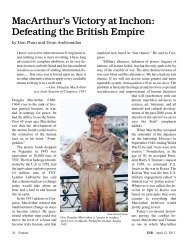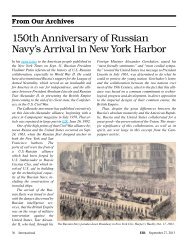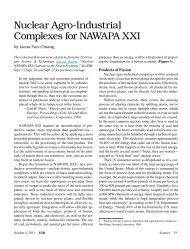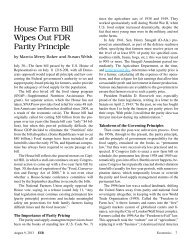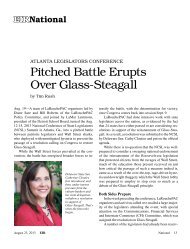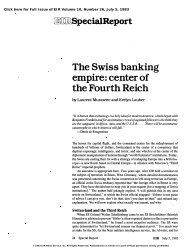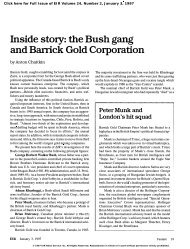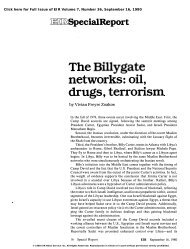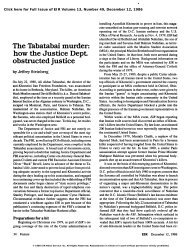View Full Issue - Executive Intelligence Review
View Full Issue - Executive Intelligence Review
View Full Issue - Executive Intelligence Review
Create successful ePaper yourself
Turn your PDF publications into a flip-book with our unique Google optimized e-Paper software.
air defense system. The missiles could achieve survivability<br />
through a mobile deployment capability, while they could<br />
have been launched at the earliest possible time following the<br />
initiation of hostilities, far sooner than NATO's ground forces<br />
and even its air forces.<br />
Furthennore, the cost-effectiveness would have been<br />
dramatically superior. According to General Berkhof, the<br />
procurement cost of 600 to 700 missiles is $1.7 million per<br />
missile, based on the cost of a lO-year deployment cycle.<br />
This compares with $50 million for one GRI Tornado aircraft<br />
and $5 million to train and support its pilot. While up to 50<br />
aircraft are required to attack one Warsaw Pact target, only<br />
one to three missiles would have been required per target.<br />
Yet, under the tenns of the INF treaty, cruise missiles<br />
have been defined as nuclear-carrying vehicles and hence all<br />
land-based cruise missiles, conventional tipped as well as<br />
nuclear, have been banned. As General Berkhof remarked,<br />
"We have given up a cheap unmanned option for a very costly<br />
manned conventional solution."<br />
Lacking the microelectronics technology required for<br />
longer�range cruise missiles, the Soviets gave up very little<br />
except their SS-20s, a missile whose power and capability<br />
had become incompatible with the Soviets' own evolving<br />
deep-strike doctrine. That doctrine has deemphasized nuclear<br />
strike in favor of conventional theater forces working in tandem<br />
with spetsnaz (special forces) and other irregular warfare<br />
capabilities in NATO's rear. Now NATO finds itself where<br />
it was 10 years ago, still facing an enemy whose capabilities<br />
are continuously being augmented under Secretary General<br />
Gorbachov's perestroika.<br />
This is not by any means to denigrate TAM 88 as an<br />
important and highly impressive demonstration of NATO's<br />
capabilities; it serves to underscore how vital these capabilities<br />
are and how they must be augmented if they are to remain<br />
effective.<br />
TAM 88<br />
The Tactical Air Meet was a vivid demonstration that<br />
NATO is an "alliance" whose most important strength must<br />
lie in cooperative and unified action. In the Warsaw Pact, the<br />
Soviet armed forces control the entire front of their Western<br />
theater of operations. Although the forces of Czechoslovakia,<br />
the Gennan Democratic Republic , and other Warsaw<br />
Pact nations should not be dismissed, particularly their air<br />
forces, they play a secondary role at best. By contrast, in<br />
NATO, each nation shares a territorial responsibility along<br />
the Gennan-Gennan border and Czechoslovakia. For instance,<br />
the two army corps and the entire air forces of Belgium<br />
and the Netherlands that constitute the entire armies of<br />
these two countries, whose total combined population is less<br />
than that of the state of California, have an area of responsibility<br />
as large as the two American army corps currently<br />
stationed in the Federal Republic of Germany. This fact, and<br />
EIR August 5, 1988<br />
the nature of war in the 1980s, create the necessity for cooperation<br />
"in depth," not possible in the "imperial" type system<br />
of the Warsaw Pact. TAM 88, as all NATO exercises, seeks<br />
first to enhance that cooperation.<br />
TAM 88 was sponsored by Allied Air Forces Central<br />
Europe, the NATO command which in time of war commands<br />
the six national air forces in NATO's Central Region.<br />
This year's host was the Canadian Air Force based in Baden<br />
S611ingen, West Gennany. Here gathered special teams comprised<br />
of 4 to 16 aircraft with their air and ground crews, and<br />
other personnel from the six Central Region national air forces,<br />
including West Gennany, the United States, the United<br />
Kingdom, Belgium, the Netherlands, and Canada. Also in-<br />
FIGURE 1<br />
NATO-Warsaw Pact combat aircraft*<br />
Fighter-bomber ground-attack<br />
-----....<br />
Fighter/interceptor**<br />
Bombers<br />
G<br />
NATO<br />
1,170<br />
2,800<br />
460<br />
<strong>Full</strong>y reinforced ____<br />
In place<br />
WARSAW PACT***<br />
<strong>Full</strong>y reinforced ____<br />
In place ____<br />
Excludes France and Spain.<br />
• U.S. estimate of 1986 NATO data.<br />
•• Excludes Soviet strategic interceptors .<br />
••• An additional 4,000 trainers are available.<br />
Source: Soviet Military Power, 1987.<br />
_________<br />
c:=J<br />
f,,;�s]<br />
_________<br />
�<br />
____________<br />
17.I2J<br />
International 45




